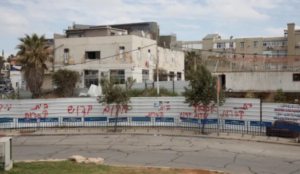Tel Aviv begins demolition of 18th-century Muslim cemetery to build homeless shelter

The site of the proposed homeless shelter in Jaffa. The spray painted barrier reads “holy site” and “cemetery,”
The Tel Aviv-Jaffa Municipality began demolishing on Monday an 18th century Muslim burial ground in Jaffa that was discovered after plans had been made to build a new homeless shelter and commercial space on the site.
About 20 demonstrators came to the construction site Monday and tried to halt the work but a large police contingent was on hand to ensure that the work could proceed. City officials have given assurances that the graves would not be damaged and that if there is a need to remove the bones of the dead, they will be reinterred elsewhere at the site.
Protesting residents displayed a large sign with a reference to Mayor Ron Huldai that read: “Huldai is desecrating Muslim graves.”
The chairman of the Jaffa Muslim Council, Tarek Ashqar, told Haaretz that the protests would be stepped up. “Huldai is as stubborn as a mule. He had an opportunity to make peace with the Muslims and the Arab community, but he’s a bully.”
In January, after two years of deliberations between the city and residents of Jaffa and the local Muslim council, the Tel Aviv District Court rejected legal challenges to the plan and cleared the way for the project.
“The court ruling is robbery. It’s not legal,” Ashqar declared. “If these were Jewish graves, this wouldn’t have happened, because Jewish bones are something else,” he said. “In Arab countries, there are also dozens of [Jewish] cemeteries that are protected because they’re graves, not because they’re Jewish. Respect for the dead has no nationality, but the Tel Aviv Municipality wants to eliminate any trace of the Muslims and Arabs of Jaffa, and everything is being covered up by the police.”
For his part, city councilman Amir Badran, said “The Muslim community in Jaffa in general and all of the city’s residents have no problem with the homeless project, and it’s appropriate to find a physical location for it, but not over a Muslim cemetery.”
![A sign reading "[Tel aviv Mayor Ron] Huladi desecrates Muslim graves," near the construction site in Jaffa, June 8, 2020.](https://ci6.googleusercontent.com/proxy/E7PmSxDhBELzihfnHAkzS9JDIWAxVGsTREKGaLChdNJPqL0QhvHSpNMYKuE0etU1CwyMDtYucCOWiiqLllcVVino5QXgYTMa-idyYYLXaL829Yry7_bVmRCetymOU0RfhCCYVcQ6FFQrxlzPBzGYuKjqTxk_2F6lJsY_WGMTmJpwThA2kFkb5bHw1LgU2ENboIWlp-PgIOWznbGc9jLbHE991QTKWE5m_Aa3KmfjgctQfQZ3NN-5-0Y7mPDkgXZr1SbR9dXXNt5HBISFA_VPfJOCJWUDiTCH0sDA7HnZs3XZeFpOQimZhynEe9_afLOnI0x3=s0-d-e1-ft#https://images.haarets.co.il/image/fetch/w_2200,h_1468,c_crop/q_auto,h_234,w_350,c_fill,f_auto/fl_lossy.any_format.preserve_transparency.progressive:none/https://www.haaretz.co.il/polopoly_fs/1.8905718!/image/3468874141.jpg)
The municipality attaches great importance to the project, he said, but “could have found a fitting alternative that would have spared a confrontation with the residents of Jaffa. The subject is very sensitive. There’s a lot of baggage from the past. Similar matters regarding the Tasso and Jamaseen cemeteries in the city are still at issue. Even if there was a court ruling, the reality requires additional rethinking regarding the building of the project.”
Tel Aviv was founded as a Jewish city just north of historically Arab Jaffa in the early 20th century. The two cities were officially merged in 1950, after the great majority of Jaffa’s residents became refugees in 1948.
Following several hours of protests, the demonstration moved to the Jaffa Clock Tower. “The clock was standing here before the police and the state and the Zionist gangs came here,” said Ramzi Kotaylat, one of the demonstrators. “Even the graves that you are desecrating were here before the state, and we, their dynasty, will also be here after the state. You are inflicting an injustice on the dead. If these had been Jewish graves, you would have changed the plans.”

Plans call for accommodations for about 80 people at the homeless shelter, to provide initial housing to homeless people who are undergoing drug rehabilitation. There are currently three similar shelters for the homeless of Tel Aviv and Jaffa. As reported by Haaretz in January, despite a 41 percent increase in the number of homeless people in the city in the past five years, the number of beds for the homeless has remained unchanged.
There had been an old Ottoman-era building at the construction site on Elisabeth Bergner Street that was used as a homeless shelter, but the municipality decided to demolish it to build a new three-story building for the homeless shelter as well as commercial space.
Work on the project began in April 2018, when the 18th century Al-Isaaf cemetery with more than 60 graves was discovered. Jaffa residents petitioned the court to stop the construction and a temporary restraining order was issued. In January, District Court Judge Avigail Cohen ruled that despite the importance of protecting the feelings of Jaffa’s Muslim residents, in this case, priority had to be given to the interests of the living over the dead.
“There is no dispute over the fact that protecting the dignity of the dead as well as the religious feelings of the Muslim community in Jaffa are important interests, but in the face of the principles presented by the Islamic council, there are constitutional principles of importance as well – the property rights of the owners of the land, and the public importance of the project – the construction of a building to rehabilitate the homeless,” she wrote.
Cohen also noted that the graves are not visible above ground and that the site was not being used as a cemetery, and “no one treated the land as if it had any religious sanctity.”
In a statement, the Tel Aviv-Yafo Municipality said:”[The city] is continuing with the construction work while being careful to protect the dignity of the dead to the extent possible. At the same time, and without any connection [to this], the municipality is continuing to pursue an arrangement for the Tasso cemetery as a Muslim cemetery and in cooperation with the community will assist with the planning and financial aspects if necessary.”
This article is published in its entirety.
